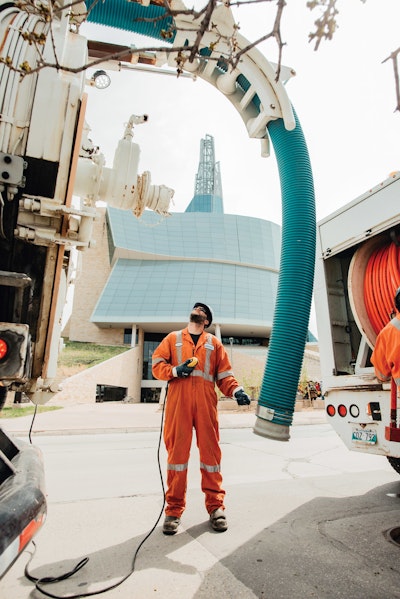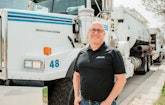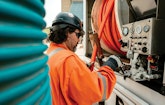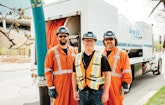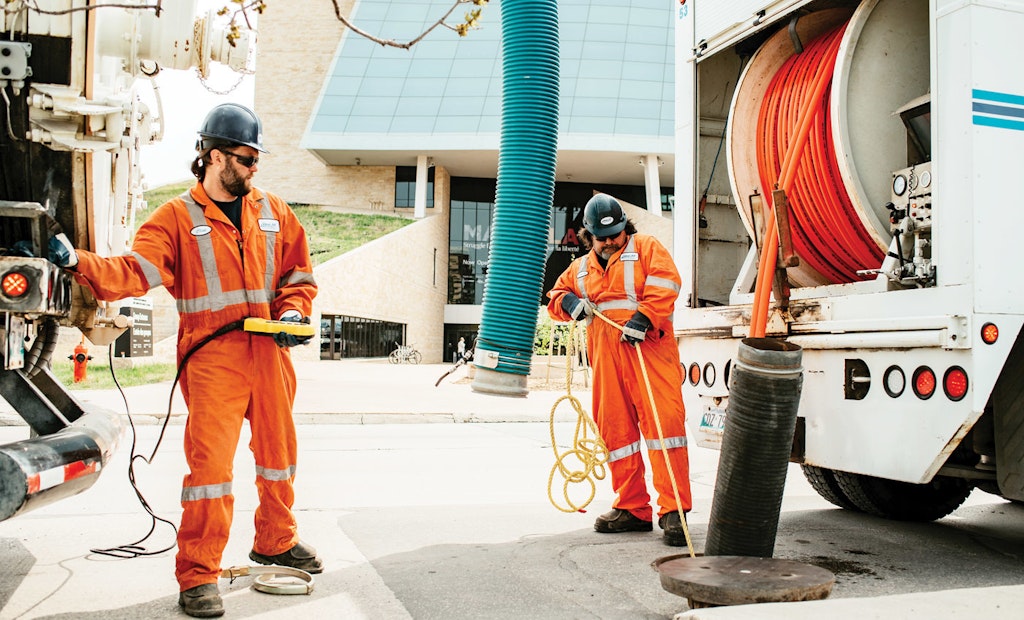
Clint Buors (left) and Shawn Staska set up one of their custom-built jet/vac trucks to clean a pipe.
Interested in Cleaning?
Get Cleaning articles, news and videos right in your inbox! Sign up now.
Cleaning + Get AlertsOn the surface, the name Uni-Jet Industrial Pipe Services provides a straightforward explanation of what the company does for clients across Canada. Nothing complicated — what you see is what you get.
But in fact, because of the work the company primarily performs — and the equipment it uses — the company stands as an outlier in the pipeline cleaning and inspection industry.
First of all, the Winnipeg, Manitoba-based company focuses mostly on large-diameter pipes, typically larger than 36 inches in diameter and up to 10 feet in diameter — pipes so big that most companies don’t have the required expertise or equipment to clean them, says Shane Cooper, the company’s operations manager.
There’s also the fact that Uni-Jet builds its own vacuum trucks and truck-mounted water jetters and hydroblasters in a 7,000-square-foot fabrication shop outfitted with welding and cutting equipment and staffed with three welders and three mechanics. The company buys truck chassis and major components such as pumps and blowers, then custom-fabricates almost everything else behind the cab, Cooper says.
Moreover, that’s not just an occasional machine here and there. Since owners Morris Baziuk and his wife, Ursula Baziuk, founded the company in 1979, employees have built nearly 75 units. That includes 35 jetter trucks, 18 vacuum trucks, seven camera vans, four hydro blasters and nine tanker trucks, says Ryan Slagerman, contract coordinator.
This large fleet of equipment positions the company to handle a variety of difficult pipe cleaning jobs from Alberta to Nova Scotia, though the bulk of its business occurs in Manitoba and western Canada, Cooper says.
The equipment has thrust the company into a leadership position in a niche market. “We’ve developed a good reputation for large-diameter pipe cleaning in Canada,” he says. “We’ll go anywhere for the right job. Once people learn about us and our capabilities, we are the go-to company.”
In addition, the cleaning and inspection work also provides added value for municipalities by helping them manage their infrastructure assets. As a result of Uni-Jet’s work, municipalities can better prioritize which sections need repairs and upgrades, as well as determine the best technology to use to make those repairs or upgrades, Cooper says.
Built by necessity
Self-fabricating machines is no simple endeavor. It takes time (about six to nine months to build a vacuum truck, for instance) and specialized skills (everything from engineering to welding). And it requires significant upfront capital expenditures for things such raw materials, labor and fabricating equipment.
So why would a company want to go through all that? In Morris Baziuk’s case, the answer was simple: He wanted to focus on cleaning large-diameter pipes, and the “off-the-shelf” equipment available at the time couldn’t get the job done.
“Morris recognized early on that there were a lot of companies doing sewer cleaning and inspections,” Cooper explains. “But there were more opportunities in large-diameter pipes because no one else was doing it — no one else had the capability.
“It was very specialized work and required a lot of capital investment as well. When he couldn’t find what he was looking for from traditional manufacturers, it triggered the thought that we should make our own equipment, designed to meet the demands of what he wanted to do.”
The topography in Manitoba contributes to the need for unusually powerful vac trucks and jetters. “Because the terrain is so flat, there’s not a lot of grade on the pipes. So the sewers tend to get fairly dirty.”
As such, Baziuk specifically designed the jetter and sewer trucks to handle tough cleaning jobs. The vacuum trucks, for instance, accommodate 10-inch-diameter Tigerflex hoses from Kuriyama of America, as opposed to conventional 8-inch-diameter hoses. That allows operators to pull more volume, which increases productivity — a competitive advantage, Cooper says.
“We can suck up bigger and heavier debris from the bottom of a pipe than a truck you’d buy off the shelf. And we use more powerful blowers to compensate for the larger-diameter hose.”
Moreover, the trucks feature a patented separation tank that allows for the vacuum unit to pump off liquids back into the sewer without shutting down the vacuum operation. This allows for longer, continuous vacuum times — critical for effective large-diameter pipe cleaning.
Furthermore, the jetting trucks are equipped with extra-large water tanks and powerful pumps. This allows for greater pressure and flow as needed, which means fewer passes required to clean out lines. That, in turn, fuels better productivity and profitability. “Being able to work more efficiently is a big competitive advantage,” Cooper says.
By fabricating its own equipment, the company is also able to continually make improvements based on immediate feedback from employees. “There’s certainly trial and error involved — we learn something from each truck we build and try to make the next one better.”
In addition, the trucks are designed to work during harsh Canadian winters.
Power and productivity
The vac trucks are built primarily on International truck chassis and are mostly used to clean sewer lines in tandem with the jetters. They feature Roots tri-lobe blowers (Howden) coupled with debris tanks ranging in size from 11 to 14 cubic yards, Slagerman says.
Most of the jetting trucks are built on International and Ford chassis, along with a few Kenworths, Peterbilts and Western Stars. They’re primarily used to clean up to 10-foot-diameter sewers. All the jetting trucks rely on Pratissoli POMPE pumps supplied by Dynablast; flow and pressure specs range from 18 gpm at 4,000 psi to 250 gpm at 2,200 psi. “The larger flusher trucks hold 3,000-gallon water tanks,” Slagerman says.
In certain applications, self-fabricated tanker trucks — mostly International chassis outfitted with recycled aluminum fuel tanks, with capacities ranging from 3,000 to 4,500 gallons — carry water to job sites to eliminate time-consuming and profit-killing refill trips.
In addition, the company runs eight camera trucks, typically built on Ford F-450s with four-wheel drive. “We do a lot of remote-access work, plus we contend with heavy snowfalls,” Slagerman says, explaining the need for four-wheel drive.
The company uses Pearpoint inspection camera systems from Radiodetection for mainline inspections and also owns a Panoramo manhole inspection camera system made by RapidView IBAK North America.
For heavy-duty industrial cleaning of tanks and pipelines at steel mills, mines, paper mills and the like, the company fabricated four truck-mounted hydro jetters, built on International chassis and featuring pumps made by Jetstream of Houston.
Meeting big challenges
A complicated, $23 million pipe lining project for Halifax Water in Halifax, Nova Scotia, exemplified the skills Uni-Jet brings to the table. The project involved lining about 2 1/2 miles of 48-inch-diameter concrete and clay sewer pipe with an Insituform Technologies felt CIPP system made by Aegion. Uni-Jet was hired to clean and inspect the sewer lines prior to lining them in 2017.
The project was even more complex because the pipes varied in shape. Not only that, the project had to be completed within a very aggressive time frame — essentially one construction season — in order to qualify for government funding. A project of this magnitude could easily have taken several years, Cooper says.
In addition, the sewer lines largely ran through the backyards of million-dollar homes and only 33 to 49 feet from the Northwest Arm, an environmentally sensitive inlet off the Atlantic Ocean that’s also a popular recreational area.
“It was one of the toughest jobs we’ve ever been a part of, but also one of my favorites,” he says, noting the sewer line was installed in 1917 and had never been cleaned. “It was a true showcase of what I believe are some of the top contractors and engineers in this field.”
Uni-Jet crews spent about three months on the project and removed approximately 915 cubic yards of debris from the lines. “We had our premier people on the job.” Despite numerous technical challenges, the project was completed on schedule.
The biggest challenge for Uni-Jet was cleaning a 3,000-foot-long stretch of pipe, with the only usable access points being manholes on each end. “It was the longest shot on the entire project,” Cooper explains. “On average, the line was about 20% full of debris — sludge, pieces of broken pipe and so forth.
“The difference-maker here was our two large flusher (jetting) trucks, generating pressure and flow of 2,200 psi at 250 gpm and 2,900 psi at 240 gpm, respectively,” he adds. “This is the kind of project for which they were built.”
Because the jetting trucks aren’t equipped with hoses long enough to reach the entire 3,000 feet and to avoid pressure loss that can accompany longer hose runs, the cleaning shot was broken into two phases. In the first stage, crews working from the upstream manhole cleaned in reverse, heading 1,000 feet downstream, then pulling debris back to the upstream manhole, where one of Uni-Jet’s vacuum trucks sucked it out. “Fortunately, the grade was fairly flat.”
In the second stage, crews were able to work in a more conventional fashion, setting up at the downstream manhole, cleaning upstream and pulling debris downstream. “We did it in stages — chunked away at it in about 50-foot increments because of the debris levels,” Cooper says. “I couldn’t tell you how many passes it took, but it was a major undertaking.”
To perform the last cleaning runs of about 2,000 feet, crews pushed out a full reel of 1,300-foot-long, doubled (fused) 1 1/4-inch-diameter hose, disconnected it, then connected another 1,300-foot-long hose to the one in the sewer line and pushed it out as well.
“This, too, was a challenge,” he says, even with the trucks’ hydraulic-powered payout and rewind capability. “I think it took about 1 1/2 hours just to pay out that 2,000 feet of hose.”
To inspect the pipe, crews were able to use alternative entry points along the line that the jetting trucks couldn’t use.
Abundant work
Even though Uni-Jet has grown considerably in the 40 years since its inception, Cooper believes there’s room for more of the same. “I still believe this is a growth industry,” he says. “As asset management becomes more prominent in the government sphere, this type of work will become much more important.
“These older systems need to be inspected to determine their condition and what’s needed to keep them maintained. And that happens through cleaning and inspection. It helps municipalities target their rehab dollars toward the most critical pieces of infrastructure.”
Given how much infrastructure there is and how much of it has reached the end of its useful life cycle, Cooper expects his crews to stay busy for the foreseeable future.
“We’re not likely to run out of work soon,” he says. “There are tons of large-diameter pipe out there — we could be busy for years just in Winnipeg alone. Our biggest obstacle is convincing clients that this kind of work on large-diameter pipes can be done — and we’re here to do it.”
Educating skeptical customers
One of the biggest challenges Uni-Jet Industrial Pipe Services faces is convincing clients that their large-diameter lines actually can be cleaned. Often enough, other contractors that aren’t experienced enough or equipped to handle large-diameter pipe jobs tell municipal officials that cleaning those lines just isn’t possible, says Shane Cooper, operations manager for the Winnipeg, Manitoba-based business.
Amid all this misinformation, Cooper’s job is to convince them that the jobs definitely are doable — even if they repeatedly hear differently from other contractors.
“Sometimes we just have to go out and show them with a demonstration that educates them about our capabilities for sewer cleaning and inspections. It’s easier for potential clients to understand when they can actually see the large volumes of water we can move with our flushers (jetters) at a very high pressure and the large amount of debris we can pull from sewers with our vac trucks.”
As an example, Cooper cites a project in Edmonton, Alberta, where three different contractors had failed in their efforts to clean a 2,800-foot-long segment of 48-inch-diameter sewer pipe in advance of a sliplining project. The cleaning was complicated by the fact that manholes for the line, which ran through a golf course and environmentally sensitive tracts of land, were up to 1,500 feet apart.
“They were going to abandon the project,” Cooper says. After a word-of-mouth referral, city officials invited Uni-Jet to make a case for giving the cleaning project another go. To get the work, Cooper made a bold promise.
“We gave them a guarantee that if we couldn’t do the work, they wouldn’t owe us a cent,” Cooper says. “That’s what we had to do to convince them to give us a try.”
That may seem like a big gamble for a business to take, especially since the job site was 1,000 miles away from Winnipeg. As such, the project included significant mobilization and demobilization costs.
But Cooper says he was confident in the company’s capabilities. “We know our guys and our equipment. We sent a supervisor with more than 25 years’ experience to look at the job. He came back and said, ‘Yes, we can do it.’ And if he says we can do it, I know we can do it.”
The supervisor was correct. Uni-Jet crews finished the job in eight days. The powerful cleaning ability of the custom-made jetting trucks made the difference, Cooper says.
“The other contractors simply didn’t have enough power to pull that much debris while using access points that were so far apart,” Cooper explains. “Sure, you get line-loss (pressure drops) when you’re working long distances like that.
“But we compensate for that by over-powering the pumps so we can still bring all that debris back to the access point. This job was a perfect example of educating customers — showing them that a job everyone else said couldn’t be done can, in fact, be done.”
